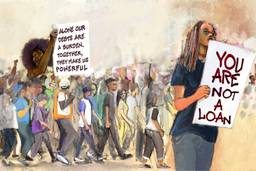
My first week of college I enjoyed my first dose of smut. The source? Squirm: The Art of Campus Sex, Vassar’s erotic magazine, which is replete with salacious prose, poetry, and photography created by and for the student body.
Squirm started four years ago when a group of Vassar students decided to create “a project that would start dialogue [and] act as a forum for queer/sex-positive ideas,” says editor Chrys Fawley.
Since official school funds were scarce at first, the staff turned to fundraisers such as a sex toy auction and a “masturbate-a-thon,” that would simultaneously create sex-positive spaces for student expression. Last year the magazine finally received partial Student Association funding but there is no evidence that such popular events will dwindle.
And Squirm is not alone. As Katha Pollitt noted in a recent article for Le Monde, “On the university campus today sex-positivity rules.”
Swarthmore publishes its own erotic magazine, Untouchables. Oberlin throws an annual all campus party called “Safer Sex Night,” which includes everything from free condoms and lube to demonstrations of S&M. A group of Smith students started a porn Web site called www.smithiegirls.com, and www.goaskalice.com, a popular sexual health Q&A forum, originated at Columbia University.
Sex-positive culture has also surfaced at public universities, yet funding at these institutions has become a point of political contention. In response to events at Penn State, which included a lecture by transgendered author Patrick Califia-Rice, State Rep. John A. Lawless tried to block funding and complained that “[these] events shouldn’t be occurring.”
College campuses have long been positively rife with sex, but what is distinct about sex-positivity is that it grows out of two other movements: the feminist health movement and AIDS education campaigns. In the ’60s and ’70s the women’s movement began pioneering a sexual revolution. The movement emphasized both women’s health and pleasure. By the early ’90s, as a result of AIDS, safer sex education became a mainstay on many college campuses. Contemporary sex-positivity echoes these developments, promoting both sexual pleasure and physical and emotional safety.
Sex-positive groups are fundamentally queer-friendly. The sexual revolution of the women’s movement endorsed non-procreative sex such as masturbation and lesbianism while AIDS activism brought homosexual practices into a more public discourse. Contemporary sex positive culture also embraces emerging identities like bisexual and transgender.
Many at Squirm view the magazine as radical. And it is, considering it was the first of what is still only a handful of campus sex publications. But if it were not for the activism of my parents’ generation—the same people who are often shocked by Squirm’s existence—my own experience would not have been possible.
Squirm started four years ago when a group of Vassar students decided to create “a project that would start dialogue [and] act as a forum for queer/sex-positive ideas,” says editor Chrys Fawley.
Since official school funds were scarce at first, the staff turned to fundraisers such as a sex toy auction and a “masturbate-a-thon,” that would simultaneously create sex-positive spaces for student expression. Last year the magazine finally received partial Student Association funding but there is no evidence that such popular events will dwindle.
And Squirm is not alone. As Katha Pollitt noted in a recent article for Le Monde, “On the university campus today sex-positivity rules.”
Swarthmore publishes its own erotic magazine, Untouchables. Oberlin throws an annual all campus party called “Safer Sex Night,” which includes everything from free condoms and lube to demonstrations of S&M. A group of Smith students started a porn Web site called www.smithiegirls.com, and www.goaskalice.com, a popular sexual health Q&A forum, originated at Columbia University.
Sex-positive culture has also surfaced at public universities, yet funding at these institutions has become a point of political contention. In response to events at Penn State, which included a lecture by transgendered author Patrick Califia-Rice, State Rep. John A. Lawless tried to block funding and complained that “[these] events shouldn’t be occurring.”
College campuses have long been positively rife with sex, but what is distinct about sex-positivity is that it grows out of two other movements: the feminist health movement and AIDS education campaigns. In the ’60s and ’70s the women’s movement began pioneering a sexual revolution. The movement emphasized both women’s health and pleasure. By the early ’90s, as a result of AIDS, safer sex education became a mainstay on many college campuses. Contemporary sex-positivity echoes these developments, promoting both sexual pleasure and physical and emotional safety.
Sex-positive groups are fundamentally queer-friendly. The sexual revolution of the women’s movement endorsed non-procreative sex such as masturbation and lesbianism while AIDS activism brought homosexual practices into a more public discourse. Contemporary sex positive culture also embraces emerging identities like bisexual and transgender.
Many at Squirm view the magazine as radical. And it is, considering it was the first of what is still only a handful of campus sex publications. But if it were not for the activism of my parents’ generation—the same people who are often shocked by Squirm’s existence—my own experience would not have been possible.
Elizabeth E. was an intern at In These Times in 2003.





